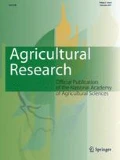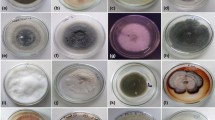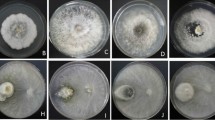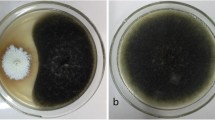Abstract
Endophytic microbes are hosted inside plants in a symbiotic and hugely benefitting relationship. In the present work, 60 asymptomatic fungi representing nine different genera were isolated from 286 plant tissues of Asparagus racemosus. Fungal endophytes were identified by ITS rDNA sequencing. Penicillium sp. was the most dominant fungus. Tissue specificity was observed by principal component analysis. Cluster analysis revealed correlation between fungal species abundance and mean temperature. Highest Shannon diversity was recorded in leaf tissues (\({H^\prime }\) = 1.279) from Delhi in 2010. Pielou’s evenness index was highest in stem tissues sampled from Hyderabad in the first survey. Of the total number of isolates examined, 12% of fungal endophytes demonstrated antifungal activity against the causal agents of four distinctive plant diseases (grey mould, stem rot, root rot and wilting, i.e. Botrytis cinerea, Sclerotinia sclerotiorum, Rhizoctonia solani and Fusarium oxysporum, respectively) in dual-culture bioassay. Penicillium sp. (isolate ARDS-2.3) and Aspergillus oryzae (isolate ARHS-1.1) displayed most effective antifungal activity with IC50 value ranging from 0.381 to 0.955 mg/ml against the broad-spectrum phytopathogens investigated.




Similar content being viewed by others
References
Arnold AE, Maynard Z, Gilbert GS, Coley PD, Kursar TA (2000) Are tropical fungal endophytes hyperdiverse? Ecol Lett 3:267–274. https://doi.org/10.1046/j.1461-0248.2000.00159.x7
Banerjee D (2011) Endophytic fungal diversity of plants in tropical and subtropical. Res J Microbiol 6(1):54–62. https://doi.org/10.3923/jm.2011.54.62
Battu GR, Kumar BM (2010) Phytochemical and antimicrobial activity of leaf extract of Asparagus racemosus Willd. Pharmacogn J 2(12):456–463
Bopana N, Saxena S (2007) Asparagus racemosus—ethnopharmacological evaluation and conservation needs. J Ethnopharmacol 110(1):1–15. https://doi.org/10.1016/j.jep.2007.01.001
Carroll GC, Carroll FE (1978) Studies on the incidence of coniferous needle endophytes in the Pacific Northwest. Can J Bot 56:3032–3043
Chhipa H, Kaushik N (2017) Fungal and bacterial diversity isolated from Aquilaria malaccensis tree and soil, induces agarospirol formation within 3 months after artificial infection. Front Microbiol 8:1286
Chowdhary K, Kaushik N (2015) Fungal endophyte diversity and bioactivity in the indian medicinal plant Ocimum sanctum Linn. PLoS ONE 10(11):e0141444. https://doi.org/10.1371/journal.pone.0141444
Chowdhary K, Kaushik N (2017) Biodiversity and in vitro inhibition study of fungal endophytes of Chlorophytum borivilianum against selected phytopathogens. PNAS India Sect B Biol Sci. https://doi.org/10.1007/s40011-017-0924-2
Chowdhary K, Kaushik N (2018) Biodiversity study and potential of fungal endophytes of peppermint and effect of their extract on chickpea rot pathogens. Arch Phytopathol Plant Prot 51(3–4):139–155
Chowdhary K, Sharma S (2017) Potential of fungal endophytes in plant growth and disease management. In: Singh D, Singh H, Prabha R (eds) Plant–microbe interactions in agro-ecological perspectives. Springer, Singapore, pp 275–290
Gherbawy YA, Elhariry HM (2014) Endophytic fungi associated with high-altitude Juniperus trees and their antimicrobial activities. Plant Biosyst. https://doi.org/10.1080/11263504.2014.984011
Huang WY, Cai YZ, Hyde KD, Corke H, Sun M (2008) Biodiversity of endophytic fungi associated with 29 traditional Chinese medicinal plants. Fungal Divers 33:61–75
Kaul S, Ahmed M, Zargar K, Sharma P, Dhar MK (2013) Prospecting endophytic fungal assemblage of Digitalis lanata Ehrh. (foxglove) as a novel source of digoxin: a cardiac glycoside. 3 Biotech 3(4):335–340
Kaur S, Dhillon GS, Brar SK, Vallad GE, Chand R, Chauhan VB (2012) Emerging phytopathogen Macrophomina phaseolina: biology, economic importance and current diagnostic trends. Crit Rev Microbiol 38(2):136–151. https://doi.org/10.3109/1040841X.2011.640977
Khan SN (2007) Macrophomina phaseolina as causal agent for charcoal rot of sunflower. Mycopath 5(2):111–118
Khan AL, Lee IJ (2013) Endophytic Penicillium funiculosum LHL06 secretes gibberellin that reprograms Glycine max L. growth during copper stress. BMC Plant Biol 13(1):86
Korejo F, Ali SA, Shafique HA, Sultana V, Ara J, Syed E-H (2013) Antifungal and antibacterial activity of endophytic Penicillium sp. isolated from Salvadora sp. Pak J Bot 46(6):2313–2318
Kumar S, Kaushik N (2013) Endophytic fungi isolated from oil-seed crop Jatropha curcas produces oil and exhibit antifungal activity. PLoS ONE 8(2):e56202. https://doi.org/10.1371/journal.pone.0056202
Kumar S, Kaushik N, Edrada-Ebel R, Ebel R, Proksch P (2011) Isolation, characterization, and bioactivity of endophytic fungi of Tylophora indica. World J Microbiol Biotechnol 27(3):571–577. https://doi.org/10.1007/s11274-010-0492-6
Rajeshwar Y, Sreekanth T, Narasimha K (2014) Free radical scavenging and antifungal activity of Asparagus racemosus root extract—an in vitro study. Int J Pharm Edu Res 1(1):57–60
Rodriguez Estrada AE, Jonkers W, Kistler HC, May G (2012) Interactions between Fusarium verticillioides, Ustilago maydis, and Zea mays: an endophyte, a pathogen, and their shared plant host. Fungal Genet Biol 49(7):578–587. https://doi.org/10.1016/j.fgb.2012.05.001
Rodriguez RJ, White JF Jr, Arnold AE, Redman ARA (2009) Fungal endophytes: diversity and functional roles. New Phytol 182(2):314–330
Rosado-Álvarez C, Molinero-Ruiz L, Rodríguez-Arcos R, Basallote-Ureba MJ (2014) Antifungal activity of asparagus extracts against phytopathogenic Fusarium oxysporum. Sci Hortic 171:51–57
Singh R, Mani VP, Khandelwal RS, Ram L, Srivastava RP (2014) Screening of maize genotypes against southern corn leaf blight. The Bioscan (Suppl Genet Plant Breed) 9(2):859–862. https://doi.org/10.1016/j.jssas.2015.06.006
Soltani J, Hosseyni Moghaddam MS (2014) Fungal endophyte diversity and bioactivity in the Mediterranean cypress Cupressus sempervirens. Curr Microbiol 70(4):580–586. https://doi.org/10.1007/s00284-014-0753-y
Sun X, Ding Q, Hyde KD, Guo LD (2012) Community structure and preference of endophytic fungi of three woody plants in a mixed forest. Fungal Ecol 5(5):624–632
Ul-Hassan SR, Strobel GA, Booth E, Knighton B, Floerchinger C, Sears J (2012) Modulation of volatile organic compound formation in the Mycodiesel-producing endophyte Hypoxylon sp. CI-4. Microbiology 158(2):465–473. https://doi.org/10.1099/mic.0.054643-0
U’Ren JM, Lutzoni F, Miadlikowska J, Laetsch AD, Elizabeth Arnold A (2012) Host and geographic structure of endophytic and endolichenic fungi at a continental scale. Am J Bot 99(5):898–914. https://doi.org/10.3732/ajb.1100459
Yuan ZL, Zhang CL, Lin FC (2010) Role of diverse non-systemic fungal endophytes in plant performance and response to stress: progress and approaches. J Plant Growth Regul 29(1):116–126
Zhang W, Wei W, Shi J, Chen C, Zhao G, Jiao R, Tan R (2015) Natural phenolic metabolites from endophytic Aspergillus sp IFB-YXS with antimicrobial activity. Biorg Med Chem Lett 25(13):2698–2701. https://doi.org/10.1016/j.bmcl.2015.04.044
Zheng LP, Zhang Z, Xie LQ, Yuan HY, Zhang YQ (2013) Antifungal activity of endophyte cultures of Morus alba L. against phytopathogenic fungi. Adv Mater Res 641–642:615–618. https://doi.org/10.4028/www.scientific.net/AMR.641-642.615
Acknowledgement
Both the authors acknowledge facilities provided by TERI, IHC. Kanika Chowdhary acknowledges CSIR-India fellowships under EMR scheme (09/550 (0037)2009-EMR-1).
Author information
Authors and Affiliations
Corresponding author
Ethics declarations
Conflict of interest
The authors declare no existence of any conflict of interest.
Electronic Supplementary Material
Below is the link to the electronic supplementary material.
Rights and permissions
About this article
Cite this article
Chowdhary, K., Kaushik, N. Diversity and Antifungal Activity of Fungal Endophytes of Asparagus racemosus Willd. Agric Res 8, 27–35 (2019). https://doi.org/10.1007/s40003-018-0341-7
Received:
Accepted:
Published:
Issue Date:
DOI: https://doi.org/10.1007/s40003-018-0341-7




